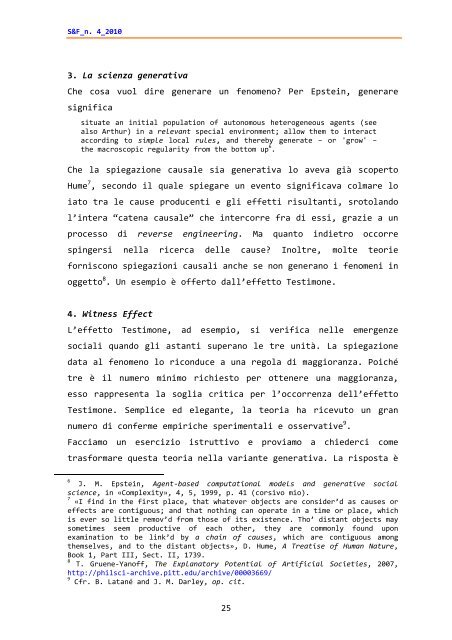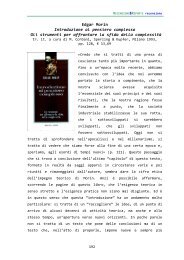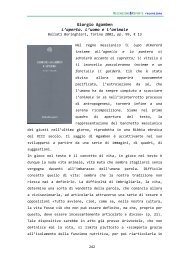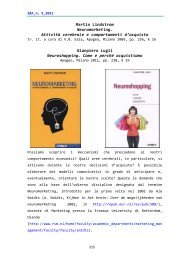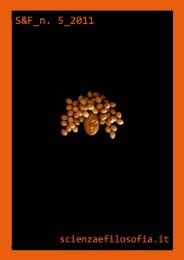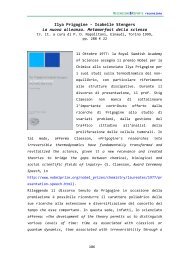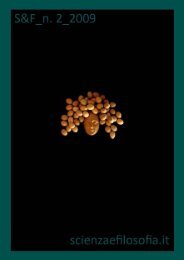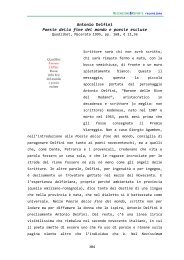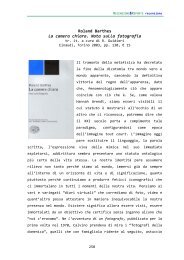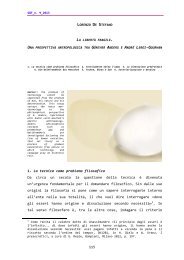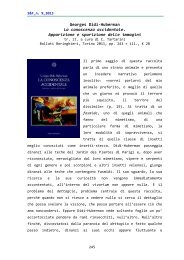Untitled - Scienzaefilosofia.It
Untitled - Scienzaefilosofia.It
Untitled - Scienzaefilosofia.It
Create successful ePaper yourself
Turn your PDF publications into a flip-book with our unique Google optimized e-Paper software.
S&F_n. 4_2010<br />
3. La scienza generativa<br />
Che cosa vuol dire generare un fenomeno Per Epstein, generare<br />
significa<br />
situate an initial population of autonomous heterogeneous agents (see<br />
also Arthur) in a relevant special environment; allow them to interact<br />
according to simple local rules, and thereby generate – or 'grow' –<br />
the macroscopic regularity from the bottom up 6 .<br />
Che la spiegazione causale sia generativa lo aveva già scoperto<br />
Hume 7 , secondo il quale spiegare un evento significava colmare lo<br />
iato tra le cause producenti e gli effetti risultanti, srotolando<br />
l’intera “catena causale” che intercorre fra di essi, grazie a un<br />
processo di reverse engineering. Ma quanto indietro occorre<br />
spingersi nella ricerca delle cause Inoltre, molte teorie<br />
forniscono spiegazioni causali anche se non generano i fenomeni in<br />
oggetto 8 . Un esempio è offerto dall’effetto Testimone.<br />
4. Witness Effect<br />
L’effetto Testimone, ad esempio, si verifica nelle emergenze<br />
sociali quando gli astanti superano le tre unità. La spiegazione<br />
data al fenomeno lo riconduce a una regola di maggioranza. Poiché<br />
tre è il numero minimo richiesto per ottenere una maggioranza,<br />
esso rappresenta la soglia critica per l’occorrenza dell’effetto<br />
Testimone. Semplice ed elegante, la teoria ha ricevuto un gran<br />
numero di conferme empiriche sperimentali e osservative 9 .<br />
Facciamo un esercizio istruttivo e proviamo a chiederci come<br />
trasformare questa teoria nella variante generativa. La risposta è<br />
6<br />
J. M. Epstein, Agent‐based computational models and generative social<br />
science, in «Complexity», 4, 5, 1999, p. 41 (corsivo mio).<br />
7 «I find in the first place, that whatever objects are consider’d as causes or<br />
effects are contiguous; and that nothing can operate in a time or place, which<br />
is ever so little remov’d from those of its existence. Tho’ distant objects may<br />
sometimes seem productive of each other, they are commonly found upon<br />
examination to be link’d by a chain of causes, which are contiguous among<br />
themselves, and to the distant objects», D. Hume, A Treatise of Human Nature,<br />
Book 1, Part III, Sect. II, 1739.<br />
8<br />
T. Gruene‐Yanoff, The Explanatory Potential of Artificial Societies, 2007,<br />
http://philsci‐archive.pitt.edu/archive/00003669/<br />
9 Cfr. B. Latané and J. M. Darley, op. cit.<br />
25


